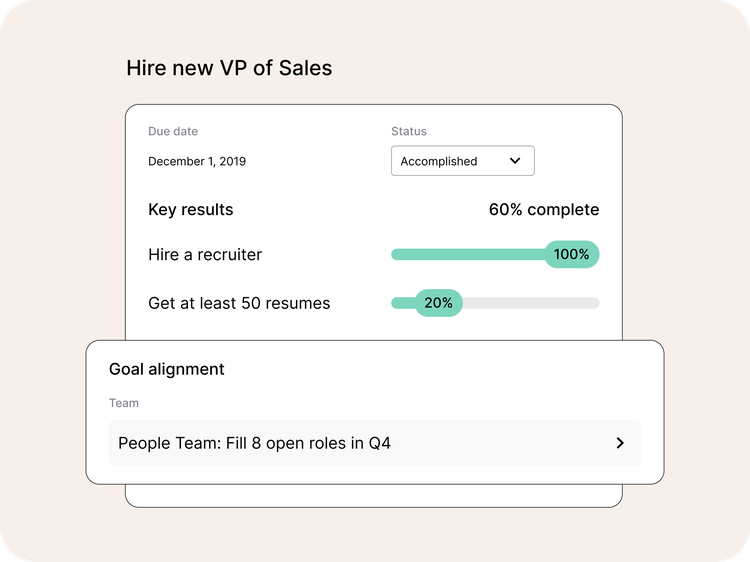
Performance management goals examples: A framework for success

Written by

Writer, Culture Amp
In this blog
Setting meaningful employee performance goals is a crucial first step toward creating a fair and motivating performance management process and retaining your best people. Clear goals help employees feel motivated and confident while also helping to prevent unconscious biases from seeping into the performance review process. Specifically, goal setting helps reduce recency bias by providing a longer-term view of employee performance and mitigating the tendency to overemphasize recent events in performance reviews.
As a manager, you hold an influential position in ensuring successful goal-setting:
- You have unique insight into your direct reports’ needs, strengths, and resources
- You’re best positioned to align individual and team goals with the company’s overarching priorities
By empowering your direct reports to set their own goals, you help them foster a sense of agency and ownership of their professional path, which will likely translate to higher engagement.
To help you support your employees in creating impactful performance targets, we’ve outlined a framework for employee goal-setting, including plenty of performance goals examples you can reference in the process. Use these tools to guide your direct reports in setting goals that are effective, engaging, and aligned with broader organizational objectives.
Using OKRs to align individual goals to organizational goals
The goal-setting framework we love and most recommend at Culture Amp is objectives and key results (OKRs).
OKRs start with a high-level objective, like “Launch a new product feature in Q1." Then, they list key results that an individual can use to evaluate success. For this example, our key results might look like this:
- Deliver internal training and enablement sessions for at least 90% of customer success and sales teams before launch.
- Drive at least 1,000 active users engaging with the new feature within the first 30 days.
- See product adoption rates of 30% in the first 30 days post-launch
OKRs are especially powerful for aligning and connecting your employees' individual goals to the company's broader vision. For example, when setting goals in the Culture Amp platform, you can easily align personal goals to broader department goals, as seen in the image below.

When done properly, OKRs create the critical alignment necessary for employees to understand how their day-to-day responsibilities impact overall business success. By creating a unified, shared vision of success, you can help employees find purpose in their work, drive engagement, and foster a culture of high performance.
Using the SMART criteria to evaluate your employee performance goals
After setting your OKRs, we recommend using SMART goals to evaluate your employees' goals. Think of SMART as a goal-setting tool to assess a goal's strength, whereas OKRs are the broader framework that encourages alignment.
In general, SMART goals allow your employees to develop a deep and precise understanding of the goal, its purpose, how to measure success, and how it connects to broader company priorities.
Goals that meet the SMART criteria are:
- Specific - Clearly defines the outcome and the owner
- Measurable - Specifies milestones, key results, and a measure of success
- Ambitious (yet attainable!) - Balances difficulty and achievability
- Relevant - Aligns with broader priorities
- Time-bound - Sets a clear deadline and milestone dates
Performance management example of a not-so-smart goal: Run 2x more webinars and increase attendance and satisfaction rates.
- This example is not specific: What does “running” mean? Is developing webinar content part of this goal? 2x more than what period?
- It’s not measurable: “Increase attendance and satisfaction rates” – but by how much?
- It’s not ambitious yet attainable: This goal might sound ambitious or attainable depending on how you view it. However, without specifying a baseline number, it may be too vague to be motivating.
- It’s not relevant: Although this example didn’t mention a specific company goal, let's assume the company’s priority is to “increase blog content production by 50%.” The example goal doesn’t directly support that.
- It’s not time-bound: There's no mention of a due date.
Performance management example of a SMART goal: Plan and execute 4 customer education webinars by April 10th, with 25+ attendees and 80%+ satisfied/very satisfied rating for each webinar.
- Specific: “Plan and execute 4 customer education webinars.”
- Measurable: “25+ attendees and 80%+ satisfied/very satisfied rating for each webinar.”
- Ambitious yet attainable: Let's assume that last year, the company executed 2 webinars with an average attendance of 18 people and an average satisfaction rate of 70%. In comparison, this new goal is challenging but likely attainable as long as the employee has proper resources and a strategy.
- Relevant: Let's say one of the company's priorities is "to invest in our community." Holding more webinars aligns with that priority.
- Time-bound: The goal needs to be achieved “by April 10th.”
Using the OKR framework, this goal may be included as a key result for an objective like, “Increase customer engagement and satisfaction through educational initiatives to enhance product knowledge and foster community relationships.”
Goals that meet the SMART criteria and follow the OKR framework are good examples of measurable, aligned goals for employees. We also encourage involving your direct reports in this goal-planning process as it helps improve employee commitment and motivation, as people are generally more invested in goals they have helped set up themselves – rather than just having them “handed” to them. It also expands their perspective to include the team's workflow and broader company performance targets.
8 examples of effective employee performance goals
Here are some sample goals you can use to help you or your direct reports craft more effective quarterly goals.
Example goal #1: Content Marketing Manager
Objective: Increase brand authority through thought leadership content.
Key Results:
- Publish 6 blog posts by June 30 with an average time-on-page of 2+ minutes.
- Generate 500+ organic views per article within 30 days of publishing.
- Secure 3 guest post opportunities on industry-relevant websites by the end of the quarter.
Example goal #2: Account Executive
Objective: Boost conversion rates by enhancing follow-up efficiency.
Key results:
- Respond to 95% of inbound leads within 2 business days for the entire quarter.
- Improve MQL-to-SQL conversion rate from 30% to 40% by the end of the quarter.
- Close 8 new deals totaling $150,000+ in revenue by the end of the quarter.
Example goal #3: Customer Success Manager
Objective: Strengthen customer retention through proactive engagement.
Key results:
- Conduct 15 QBRs (Quarterly Business Reviews) with key accounts by June 30.
- Achieve a 90% or greater satisfaction score on post-QBR surveys.
- Reduce churn in assigned accounts from 8% to 5% by the end of Q2.
Example goal #4: Software Engineer
Objective: Improve platform performance by reducing technical debt.
Key results:
- Refactor and document 5 legacy modules by September 15.
- Decrease average page load time from 2.8s to 2.0s on core user flows.
- Resolve 90% or more open performance-related bugs in the backlog by the end of the quarter.
Example goal #5: Learning & Development Coordinator
Objective: Enhance the employee onboarding experience for new hires.
Key results:
- Redesign the onboarding checklist and materials by May 15.
- Deliver 4 live onboarding sessions by June 30, with 80% or higher new hire attendance.
- Improve average onboarding satisfaction rating from 76% to 90% on post-onboarding experience surveys.
Example goal #6: Social Media Manager
Objective: Elevate brand storytelling through community engagement.
Key results:
- Source and share 10 user-generated content posts by May 30 that receive over 100+ engagements per post.
- Launch a brand campaign with 50+ participants creating original content using our hashtag.
- Schedule 2 “Live AMA” sessions with employees from different departments to humanize the brand by June 15.
Example goal #7: UX Designer
Objective: Improve user satisfaction through impactful design updates.
Key results:
- Conduct 3 “think-aloud” usability tests with users unfamiliar with the product by August 20.
- Reduce time-to-completion for the onboarding flow by 25% by the end of the quarter.
- Implement 3+ “delight moments” (microinteractions, surprise messages, subtle animations) into the product by the end of Q3.
Example goal #8: Sales Development Representative
Objective: Build stronger prospect relationships through personalized outreach.
Key results:
- A/B test 3 new intro email formats and track open + reply rates weekly through the end of the quarter.
- Record and self-review 10 prospect calls with a peer by May 30 using a coaching rubric.
- Share one customer story per month with the marketing team to help inform future case studies.
Measure and optimize employee performance goals
Now that you’ve included your direct reports in the goal-setting process, provided them with examples of measurable goals, and worked with them to diversify the types of goals they’re setting, what’s next? Check in with employees about how goal-setting is going.
Key questions to guide goal and OKR setting at your company
Culture Amp recommends asking these seven questions in your organization’s next employee survey or pulse survey to measure how goal-setting is perceived at your company:
- I understand how my role contributes to the organizational goals of my company
- We have a shared strategy for how to achieve our goals
- My manager (or someone in leadership) collaborates with me in setting my goals at work
- My manager helps us set a clear strategy for achieving our goals
- My goals are set in a way that stretches me to achieve more
- Speaking openly about obstacles to accomplishing goals (getting the work done) is encouraged here
- We regularly check in on how we are progressing toward our goals
Once your survey ends, follow these steps to get the most out of your data and ensure your employees find your business’s approach to goal-setting effective:
- Analyze results by team and department: Break down the data to identify strengths and areas for improvement across different groups within your organization. A goal-setting framework that works well for straightforward business models like sales may be less effective for more complex, creative, or dynamic environments, like design or research and development. Analyzing results by department can help you uncover teams that might benefit from a more tailored goal-setting approach.
- Focus on actionable insights: Use the survey responses to pinpoint specific adjustments, such as improving goal alignment, providing clearer guidance, or fostering a culture of open communication about challenges.
- Facilitate open conversations: Share key takeaways with employees and create opportunities for discussion. For example, have managers from lower-scoring teams discuss what’s working and what isn’t with their employees – this transparency helps build trust and encourages collaboration in refining goal-setting processes.
- Incorporate feedback into OKR planning: Now it’s time to use the insights and ideas you’ve gathered. Integrate employee input into your next cycle of goal and OKR setting to better align your strategy with employees’ unique needs and perspectives.
By continuously iterating and involving employees in the process, you can foster a goal-setting culture that drives alignment, accountability, and performance across your organization.
Tools and technologies for effective performance management
Another way to improve your goal-setting strategy is with performance management software. Investing in dedicated goal-setting solutions sends a strong message to employees that setting and tracking goals is a top priority for your business. Performance management software offers other perks, too – greater visibility into goal progress and roadblocks, better alignment, increased accountability, and data-driven decision-making.
Sound enticing? Here are a few performance management software tools to consider investing in for improved performance:
1. Goal-setting software
Goal-setting software helps employees treat goals with the importance they deserve. Entering individual goals into a centralized system and aligning them with broader organizational performance targets gives employees a clear definition of success to strive for. This transparency drives accountability and alignment while also ensuring employee contributions support overall business objectives.
For managers, the tool provides even more benefits. It allows you to:
- Track performance and address roadblocks in real time
- Enable timely, ongoing coaching and feedback
- Proactively identify risks and make data-driven decisions
- Drive overall business success by aligning efforts across teams
By streamlining goal management, goal-setting software fosters alignment, accountability, and continuous improvement.
2. Feedback software
Giving and receiving constructive feedback is a key element of the performance management process. When delivered at the right time, feedback can inspire employees to improve and even push them to exceed their goals. But too often, feedback is mentioned in passing without proper follow-up and fails to drive meaningful action.
A formal feedback tool can change this by storing all constructive feedback, whether it comes from you or your employees' peers, in one centralized location. Saving feedback in an accessible place keeps it top of mind throughout the year, making it easier for you to coach employees effectively and increasing the likelihood that they’ll take the feedback to heart.
Need help crafting actionable and constructive feedback? Explore our post on "Employee feedback: Examples to guide and drive development" for best practices on fostering a culture of continuous improvement within your team.
3. 1-on-1 software
One of the best ways to stay on top of goal progress and help employees as issues arise is through ongoing communication via regular 1-on-1 meetings. A tool like Culture Amp’s 1-on-1 conversations can enhance these weekly conversations by allowing you to:
- Collaborate with your direct report on a shared meeting agenda
- Check in on employee sentiment
- Access best practices and coaching tips
- Track discussion points, list action items, and maintain a record of past meetings
Storing this information in one place ensures accountability, prevents important details from slipping through the cracks, and keeps conversations focused and productive so you can make the most of your time together. Regular 1-on-1s also provide employees with a dedicated space to discuss goal progress, surface any issues holding them back, and brainstorm the best path forward. These conversations help them stay on track and get the support and resources they need to achieve their objectives.
4. Performance review software
When it’s time to conduct formal performance reviews, comprehensive performance management software can simplify the process and ensure evaluations are more accurate and fair. Plus, it can help minimize bias in performance evaluations, allowing you to deliver more equitable reviews. Tools like 360-degree feedback (incorporating input from self-evaluations, peers, and managers), detailed goal progress tracking from the entire review period, and formal calibrations can help you build trust and credibility in the performance review process.
A better performance review process
As you take steps to elevate your performance review process, we hope you’ll remember a few key takeaways from the performance management examples shared in this article:
- SMART goals provide clarity and help employees understand how your business measures success
- OKRs align individual and organizational goals
- Setting various goal types can foster both individual and team growth
- Regularly survey employees on how goal-setting is perceived and make improvements based on their feedback
Investing in goal-setting tools like Culture Amp’s OKR software can help your business turn business objectives into motivating employee goals. If you’re looking to learn even more about effective goal-setting and best practices for motivating your employees, we recommend checking out HR's complete guide to performance management.




